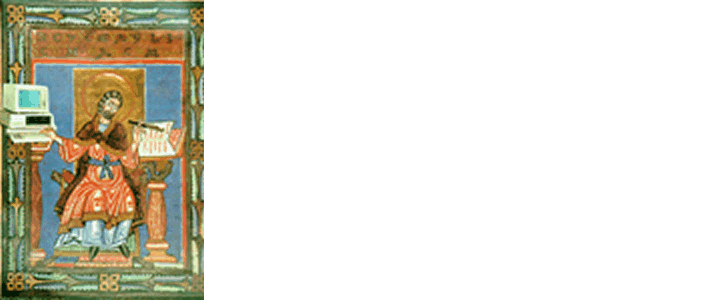 |
|
| |
|
Exegesis
|
| |
| |
|
Redaction Criticism
| |

|
Definition
|
- Redaction
criticism is the study of the theological perspective of a biblical
text evident in its collection, arrangement, editing and modification
of sources.* A redactor’s editorial activity is easiest
to discern when we have several parallel versions of the same
story, as we do in the four gospels. The redaction
critic examines such parallel texts to determine what material
is shared amongst them, what material is unique to each, and how
each author shapes the material for his/her own community. Insofar
as we can discern this shaping activity, we can begin to reconstruct
the life and perspective of each authorial community.

| |

|
Method
|
- To
examine a text as a redaction critic would, follow this procedure:
- Compare your text against the other gospel accounts of the same event. The standard tool used for this comparison is a synopsis or parallel arrangement of the gospels. The English language version is B. H. Throckmorton, Jr., ed., Gospel Parallels: A Synopsis of the First Three Gospels, 5th ed.) available in Orradre.
-
- Isolate shared material - notice what words, phrases and stories are shared and by whom they are shared/not shared. Make a list of the similarities and differences.
- Isolate unique material - notice what words, phrases and stories are unique to this gospel author. Make a separate list of those.
-
- Account for the similarities and differences you have
found.
-
- Review background materials - Study the material in a good study Bible (for example, the Catholic Study Bible) or biblical commentary on the current theory of gospel composition, the Two-Source Hypothesis. Also, study an introduction to each gospel to get a sense of the authorial communities behind each gospel.
- Assess the data on your gospel passage - review the material your gospel shares with other gospels, and assess this against the Two Source Hypothesis (what is based on Mark, and what on Q?). Review the unique material and arrangement of material in your gospel and assess this against what you know of your evangelist’s background and community.
- Summarize your evangelist’s theological and ecclesiological perspective - what is your evangelist’s view of God and Christ, especially insofar as this differs from the other gospels? What is your evangelist’s view of the disciples? Are any particular disciples singled out for praise or correction? What might this indicate about authority structures in the author’s community?

| |

|
Bibliography
|
- Tools
 Aland, Kurt, ed. Synopsis of the Four Gospels, English
edition. New York: United Bible Societies, 1982.
Aland, Kurt, ed. Synopsis of the Four Gospels, English
edition. New York: United Bible Societies, 1982.
-
 Funk, Robert W. New Gospel Parallels. Philadelphia:
Fortress, 1985.
Funk, Robert W. New Gospel Parallels. Philadelphia:
Fortress, 1985.
-
 Throckmorton, Burton H, ed. Gospel Parallels, 3d ed. New York: Nelson, 1967.
Throckmorton, Burton H, ed. Gospel Parallels, 3d ed. New York: Nelson, 1967.
-
- Gospel
Synopses - Compare the gospel accounts through synopses
of the five gospels (Mark, Matthew, Luke, John, Thomas), the
four canonical gospels, the three synoptic gospels, or any
single gospel.
-
- Method
 Perrin, Norman. What is Redaction Criticism?,
Guides to Biblical Scholarship, New Testament Series. Philadelphia:
Fortress, 1969.
Perrin, Norman. What is Redaction Criticism?,
Guides to Biblical Scholarship, New Testament Series. Philadelphia:
Fortress, 1969.
-
- Applications
- Bovon,
François. "Tracing the Trajectory
of Luke 13,22-30 back to Q: A Study in Lukan Redaction." In
From Quest to Q: Festschrift for James M. Robinson
(ed. Jon Ageirsson, Kristin De Troyer and Marvin W. Meyer;
Leuven: Peeters, 2000).
-
 Kingsbury, Jack Dean. The Parables of Jesus
in Matthew 13: A Study in Redaction-criticism. London:
S.P.C.K., 1969.
Kingsbury, Jack Dean. The Parables of Jesus
in Matthew 13: A Study in Redaction-criticism. London:
S.P.C.K., 1969.
-
 Nelson, Richard D. The Double Redaction of
the Deuteronomistic History. Sheffield: JSOT/Department
of Biblical Studies, University of Sheffield, 1981.
Nelson, Richard D. The Double Redaction of
the Deuteronomistic History. Sheffield: JSOT/Department
of Biblical Studies, University of Sheffield, 1981.
-
 Neyrey, Jerome. The Passion According to Luke:
A Redaction Study of Luke's Soteriology. New
York: Paulist Press, 1985.
Neyrey, Jerome. The Passion According to Luke:
A Redaction Study of Luke's Soteriology. New
York: Paulist Press, 1985.
-
 Peabody, David Barrett. Mark as Composer. Leuven/
Macon, Georgia: Peeters/Mercer University Press, 1987.
Peabody, David Barrett. Mark as Composer. Leuven/
Macon, Georgia: Peeters/Mercer University Press, 1987.
-
 Telford, William R. The Barren Temple and
the Withered Tree: A Redaction-critical Analysis of the
Cursing of the Fig-tree Pericope in Mark's Gospel and Its
Relation to the Cleansing of the Temple Tradition. Sheffield:
JSOT, 1980.
Telford, William R. The Barren Temple and
the Withered Tree: A Redaction-critical Analysis of the
Cursing of the Fig-tree Pericope in Mark's Gospel and Its
Relation to the Cleansing of the Temple Tradition. Sheffield:
JSOT, 1980.
-
 Williamson, H. G. M. The Book called Isaiah:
Deutero-Isaiah's Role in Composition and Redaction. New
York: Oxford University Press, 1994.
Williamson, H. G. M. The Book called Isaiah:
Deutero-Isaiah's Role in Composition and Redaction. New
York: Oxford University Press, 1994.
|
|
| |
|
|
|